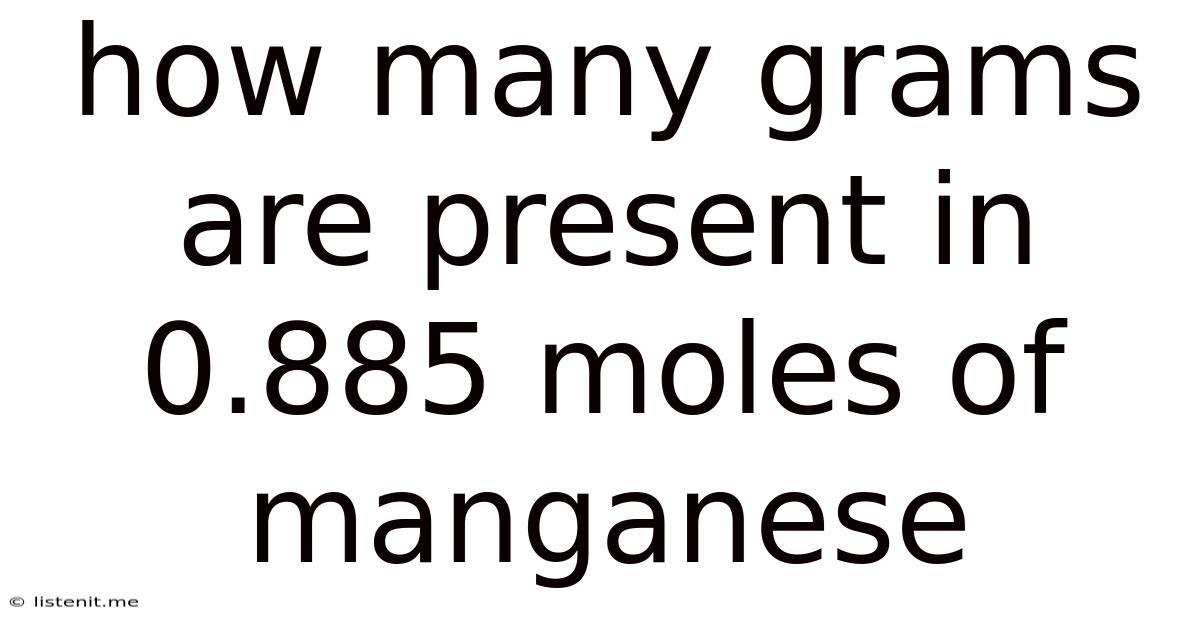How Many Grams Are Present In 0.885 Moles Of Manganese
listenit
May 11, 2025 · 4 min read

Table of Contents
How Many Grams are Present in 0.885 Moles of Manganese? A Comprehensive Guide
Determining the mass of a substance given its number of moles is a fundamental concept in chemistry. This article will comprehensively guide you through calculating the grams present in 0.885 moles of manganese, explaining the underlying principles and providing additional context to enhance your understanding of molar mass and stoichiometry.
Understanding Moles and Molar Mass
Before diving into the calculation, let's solidify our understanding of key terms:
-
Mole (mol): The mole is the International System of Units (SI) base unit for the amount of substance. It represents a specific number of entities, whether atoms, molecules, ions, or other particles. This number is Avogadro's number, approximately 6.022 x 10²³. One mole of any substance contains Avogadro's number of constituent particles.
-
Molar Mass (g/mol): The molar mass is the mass of one mole of a substance. It's expressed in grams per mole (g/mol). The molar mass of an element is numerically equivalent to its atomic weight (found on the periodic table), but with the unit g/mol. For compounds, the molar mass is the sum of the atomic masses of all the atoms in the chemical formula.
Calculating the Mass of Manganese
To find the mass of 0.885 moles of manganese (Mn), we need its molar mass. Consulting the periodic table, we find that the atomic weight of manganese is approximately 54.94 atomic mass units (amu). Therefore, the molar mass of manganese is approximately 54.94 g/mol.
The calculation involves a simple conversion:
- Moles (mol) x Molar Mass (g/mol) = Mass (g)
Substituting the known values:
0.885 mol Mn x 54.94 g/mol Mn = 48.6 g Mn
Therefore, 0.885 moles of manganese contain approximately 48.6 grams of manganese.
Expanding on the Concept: Stoichiometry and Chemical Reactions
The ability to convert between moles and grams is crucial in stoichiometry, the branch of chemistry that deals with the quantitative relationships between reactants and products in chemical reactions. Let's consider a simple example:
Imagine a reaction where manganese reacts with oxygen to form manganese(II) oxide (MnO):
2Mn + O₂ → 2MnO
If we want to determine the mass of manganese(II) oxide produced from 0.885 moles of manganese, we need to follow these steps:
-
Moles of Manganese to Moles of Manganese(II) Oxide: The balanced equation shows a 2:2 mole ratio between Mn and MnO. Therefore, 0.885 moles of Mn will produce 0.885 moles of MnO.
-
Moles of Manganese(II) Oxide to Grams of Manganese(II) Oxide: We need the molar mass of MnO. This is calculated by adding the atomic masses of manganese and oxygen: 54.94 g/mol (Mn) + 16.00 g/mol (O) = 70.94 g/mol (MnO).
-
Final Calculation: 0.885 mol MnO x 70.94 g/mol MnO = 62.7 g MnO
Thus, 0.885 moles of manganese would produce approximately 62.7 grams of manganese(II) oxide in this specific reaction.
Significance of Accurate Measurements and Calculations
Accurate molar mass values are critical for precise stoichiometric calculations. Slight variations in the atomic masses used from different sources might lead to minor discrepancies in the final results. However, the fundamental process remains consistent.
Precise measurements are equally important in laboratory settings. Using accurate balances and volumetric equipment ensures reliable experimental data that align with theoretical calculations.
Beyond Manganese: Applications Across Chemistry
The concept of converting moles to grams is universally applicable across all chemical elements and compounds. This fundamental conversion factor is essential in numerous areas of chemistry, including:
- Analytical Chemistry: Determining the concentration of substances in solutions.
- Organic Chemistry: Calculating the yield of reactions involving organic molecules.
- Inorganic Chemistry: Synthesizing and characterizing inorganic compounds.
- Physical Chemistry: Understanding the behavior of gases and solutions.
Troubleshooting Common Mistakes
-
Unit Consistency: Always ensure consistency in units throughout your calculations. Mixing grams and kilograms, for example, will lead to incorrect answers.
-
Significant Figures: Pay attention to significant figures. The final answer should reflect the precision of the measurements and constants used in the calculation. In the example above, using 54.94 g/mol for manganese suggests we should report the final answer with four significant figures.
-
Periodic Table Accuracy: Ensure you are using a reliable periodic table with updated atomic masses. Slight variations exist between different versions.
Conclusion: Mastering Mole-to-Gram Conversions
Mastering the conversion between moles and grams is a fundamental skill for success in chemistry. This article provided a detailed explanation of the process, its significance in stoichiometry, and practical considerations for accuracy. Understanding these concepts opens doors to tackling more complex chemical problems and solidifies a strong foundation in chemical principles. Remember to always double-check your work, pay attention to detail, and utilize a reliable periodic table to achieve accurate and meaningful results. By consistently applying these principles, you'll be well-equipped to confidently solve various quantitative chemical problems.
Latest Posts
Latest Posts
-
What Is The Shape Of 3p Atomic Orbital
May 12, 2025
-
Square Root Of 50 Rational Or Irrational
May 12, 2025
-
How To Prove A Function Is Odd
May 12, 2025
-
0 36 As A Fraction In Simplest Form
May 12, 2025
-
Formula To Find Perimeter Of Square
May 12, 2025
Related Post
Thank you for visiting our website which covers about How Many Grams Are Present In 0.885 Moles Of Manganese . We hope the information provided has been useful to you. Feel free to contact us if you have any questions or need further assistance. See you next time and don't miss to bookmark.